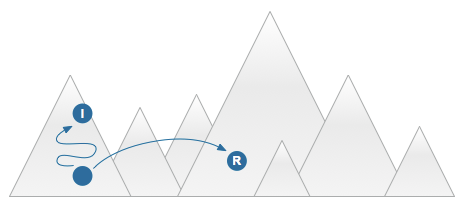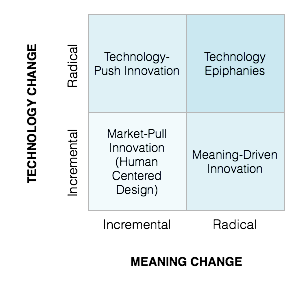Norman was bothered by his analysis and tried to find examples that refuted this conclusion: he failed. Every radical innovation he investigated was done without design research, without careful analysis of a person’s or even a society’s needs.
— Norman D., Verganti R. (2012) Incremental and Radical innovation
The metaphor used in the paper is a common and very effective one: incremental innovation is like being on a mountain and trying to reach the top of it. Radical innovation instead is like jumping to a new mountain with the hope that it’s higher than the one you are on.

Understanding this is very important because it shows you the advantages and risks of both approaches. The incremental approach is very effective when grounded in research and is the one leading to the top, step by step. On the other side the radical approach isn’t usually grounded in research and has a quite high failure ratio because you can’t predict on which mountain you are going to land.
However, you can clearly see that:
Radical innovations seldom live up to their potential when first introduced. At first, they are often difficult to use, expensive, and limited in capability. Incremental innovation is necessary to transform the radical idea into a form that is acceptable to those beyond early adopters.
The bottom line is that both forms of innovation are necessary.
I think that you can see this clearly with startups. A startup by itself is usually an attempt in doing radical innovation, but in the principle it’s very very rough and requires lots of work to start growing and showing the full potential. Plus, if the idea isn’t delivering – the mountain isn’t as high as imagined – the startup usually pivots.
The paper goes on showing the two main dimensions where innovation can happen.
We conclude that human-centered design, with its emphasis on iterated observation, ideation, and testing is ideally suited for incremental innovation and unlikely to lead to radical innovation. Radical innovation comes from changes in either technology or meaning. Technology-driven innovation often comes from inventors and tinkerers. Meaning-driven innovation, however, has the potential to be driven through design research, but only if the research addresses fundamental questions of new meanings and their interpretation.
And this is the most interesting part: technology and meaning, as two dimensions where innovation can happen. The two are related, and as such there’s always a bit of each in every innovation. The accent is where the main shift happens.

Let’s see briefly a few examples from the paper:
- Market-Pull Innovation: any user centered design approach.
- Technology-Push Innovation: the introduction of the color TV, the Xerox copier, the electronic calculator.
- Meaning-Driven Innovation: the shift of watches from tools to fashion accessories, the invention of the mini-skirt in 1960s as a symbol of women’s freedom.
- Technology Epiphanies: the Wii, using a new technology to change the space of video games.
Clearly, the Market-Pull Innovation is safer, while the Technology Epiphanies are way more difficult, also due to the resistance of the users to change.
You can find the full paper in PDF on this page. It’s worth a read. Norman and Verganti do a great work in detailing these two dimensions with some excellent examples and models.